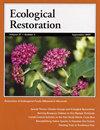Plant, Avian, and Butterfly Response to a Native-Grassland Restoration in Southern Texas
IF 1.1
4区 环境科学与生态学
Q2 ECOLOGY
引用次数: 1
Abstract
ABSTRACT Non-native, invasive grasses can pose a threat to biodiversity in the southern U.S. Pennisetum ciliare (buffelgrass) is an example of an introduced invasive grass that has established in southwestern rangelands and negatively influenced biodiversity. Since its introduction, millions of hectares in the southwestern U.S. have been planted with, or invaded by, buffelgrass. Buffelgrass can form monocultures that not only reduce biodiversity but can also change ecosystem processes. Native-grassland restorations may be able to mitigate such negative impacts of non-native grasses. We conducted a study to document the response of herbaceous plants (grasses and forbs) and wildlife (grassland breeding birds, grassland wintering birds, and butterflies) to a 118-ha grassland restoration (involving prescribed fire, multiple discing and herbicide applications, and native-plant seeding) in La Salle County, Texas during 2013–2019. In general, we documented a numerical increase for all three taxa (native plants, birds, and butterflies) in species richness and relative abundance on the restoration site compared to a control. Our results suggest that native-grassland restoration is possible in a landscape dominated by buffelgrass. These restoration efforts can increase plant and wildlife diversity, although the time and expense required to achieve such responses are great.植物、鸟类和蝴蝶对德克萨斯州南部原生草原恢复的反应
摘要:在美国南部,非本土入侵草可能对生物多样性构成威胁。狼尾草(水牛草)是一种引入的入侵草,它已在西南部牧场建立,并对生物多样度产生负面影响。自引进以来,美国西南部数百万公顷的土地上种植或被水牛草入侵。水牛草可以形成单一栽培,不仅减少生物多样性,还可以改变生态系统过程。原生草地的恢复可能能够减轻非原生草地的负面影响。我们进行了一项研究,以记录2013-2019年期间,德克萨斯州拉萨尔县草本植物(草和禁种植物)和野生动物(草原繁殖鸟类、草原越冬鸟类和蝴蝶)对118公顷草原恢复(包括规定的火灾、多次喷洒和除草剂以及本地植物播种)的反应。总的来说,与对照组相比,我们记录了恢复现场所有三个分类群(本地植物、鸟类和蝴蝶)的物种丰富度和相对丰度的数量增加。我们的研究结果表明,在以水牛草为主的景观中,原生草原的恢复是可能的。这些恢复工作可以增加植物和野生动物的多样性,尽管实现这些响应所需的时间和费用都很大。
本文章由计算机程序翻译,如有差异,请以英文原文为准。
求助全文
约1分钟内获得全文
求助全文
来源期刊

Ecological Restoration
Environmental Science-Nature and Landscape Conservation
CiteScore
1.70
自引率
12.50%
发文量
24
期刊介绍:
Ecological Restoration is a forum for people advancing the science and practice of restoration ecology. It features the technical and biological aspects of restoring landscapes, as well as collaborations between restorationists and the design professions, land-use policy, the role of education, and more. This quarterly publication includes peer-reviewed science articles, perspectives and notes, book reviews, abstracts of restoration ecology progress published elsewhere, and announcements of scientific and professional meetings.
 求助内容:
求助内容: 应助结果提醒方式:
应助结果提醒方式:


